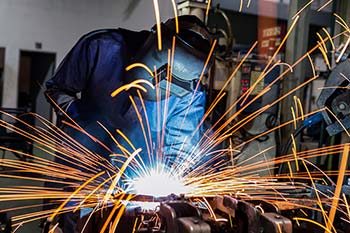Many industries rely on welding. This process of joining metals requires a heat source, a metal, filler material, and a shield from the fumes. It can be dangerous and unhealthy without proper safeguards. Here are ways to reduce injuries.

1Wear protective clothing
Common welding processes use an open electric arc or flame, so the risk of burns or fire is high. Wear flame-resistant clothing, including heavy leather gloves, long-sleeve jackets, leather aprons, and high-top, hard-toed shoes to avoid sparks and flames.
2Wear eye protection
The ultraviolet (UV) light of the welding area can damage the eyes. Wear goggles and welding helmets with dark UV-filtering faceplates when welding. Welding curtains surrounding the area can also help protect bystanders.
3Ventilate the work area
The fumes from the weld spot contain dangerous toxic gases and heavy metal particles. Fumes and gases can build up quickly and explode. In confined spaces, ventilate the area and direct airflow across the face of the welder to remove fumes.
4Use a respirator
A welder can be exposed to coatings, bases, paints, fillers, and other elements that give off toxic fumes and vapors. Proper respirator use is recommended.
5Lose the clutter
Welding produces heat, fumes, and sparks that could cause a fire or explosion.. Weld only in areas free of trash, wood, paper, chemicals, plastics, and gases. Vapors can travel hundreds of feet. Use heat shields or guards around anything that could catch fire. Keep a fire watch for at least a half-hour after welding or cutting.
